The AMD Ryzen Threadripper 3960X and 3970X Review: 24 and 32 Cores on 7nm
by Dr. Ian Cutress, Andrei Frumusanu & Gavin Bonshor on November 25, 2019 9:05 AM ESTCPU Performance: Encoding Tests
With the rise of streaming, vlogs, and video content as a whole, encoding and transcoding tests are becoming ever more important. Not only are more home users and gamers needing to convert video files into something more manageable, for streaming or archival purposes, but the servers that manage the output also manage around data and log files with compression and decompression. Our encoding tasks are focused around these important scenarios, with input from the community for the best implementation of real-world testing.
All of our benchmark results can also be found in our benchmark engine, Bench.
Handbrake 1.1.0: Streaming and Archival Video Transcoding
A popular open source tool, Handbrake is the anything-to-anything video conversion software that a number of people use as a reference point. The danger is always on version numbers and optimization, for example the latest versions of the software can take advantage of AVX-512 and OpenCL to accelerate certain types of transcoding and algorithms. The version we use here is a pure CPU play, with common transcoding variations.
We have split Handbrake up into several tests, using a Logitech C920 1080p60 native webcam recording (essentially a streamer recording), and convert them into two types of streaming formats and one for archival. The output settings used are:
- 720p60 at 6000 kbps constant bit rate, fast setting, high profile
- 1080p60 at 3500 kbps constant bit rate, faster setting, main profile
- 1080p60 HEVC at 3500 kbps variable bit rate, fast setting, main profile
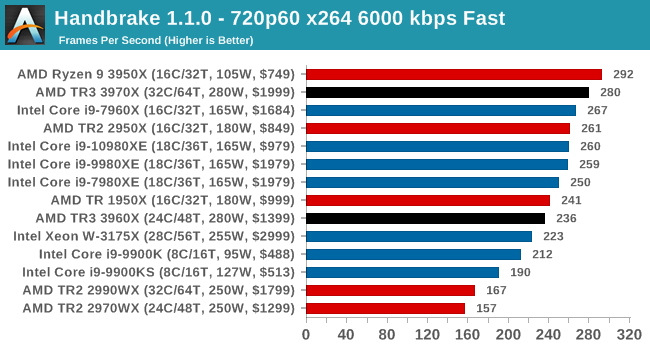
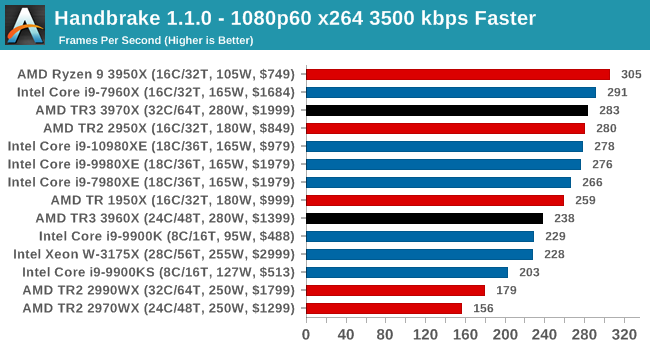
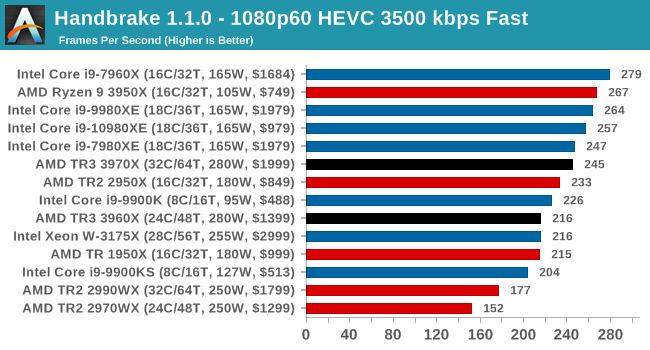
Video encoding is a little varied, based on the variable threaded nature. Certain encoding tests can be more memory sensitive here, or accelerated in different ways, or not scale well with more cores. Either way, TR3 performs a lot better than TR2, but the 3950X seems the best choice.
7-zip v1805: Popular Open-Source Encoding Engine
Out of our compression/decompression tool tests, 7-zip is the most requested and comes with a built-in benchmark. For our test suite, we’ve pulled the latest version of the software and we run the benchmark from the command line, reporting the compression, decompression, and a combined score.
It is noted in this benchmark that the latest multi-die processors have very bi-modal performance between compression and decompression, performing well in one and badly in the other. There are also discussions around how the Windows Scheduler is implementing every thread. As we get more results, it will be interesting to see how this plays out.
Please note, if you plan to share out the Compression graph, please include the Decompression one. Otherwise you’re only presenting half a picture.
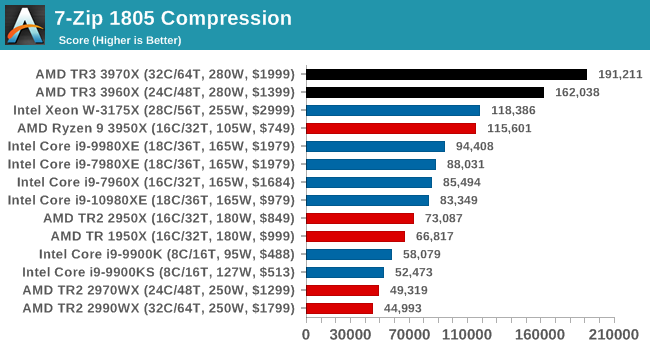
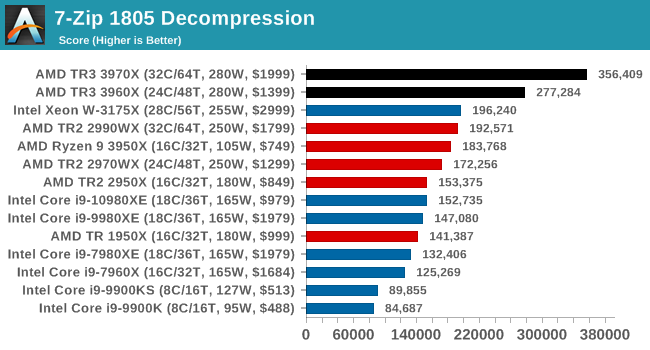
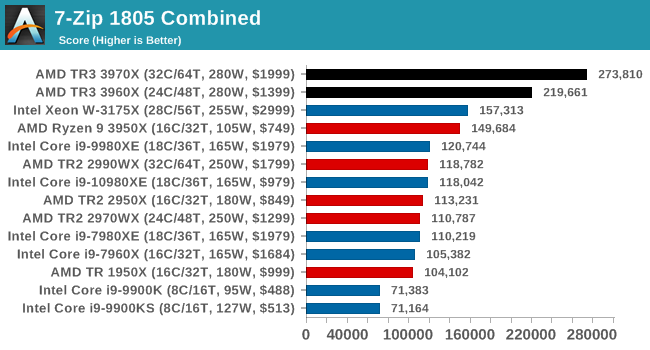
Easily parallel puts the TR3 well ahead of TR2 and Intel.
WinRAR 5.60b3: Archiving Tool
My compression tool of choice is often WinRAR, having been one of the first tools a number of my generation used over two decades ago. The interface has not changed much, although the integration with Windows right click commands is always a plus. It has no in-built test, so we run a compression over a set directory containing over thirty 60-second video files and 2000 small web-based files at a normal compression rate.
WinRAR is variable threaded but also susceptible to caching, so in our test we run it 10 times and take the average of the last five, leaving the test purely for raw CPU compute performance.
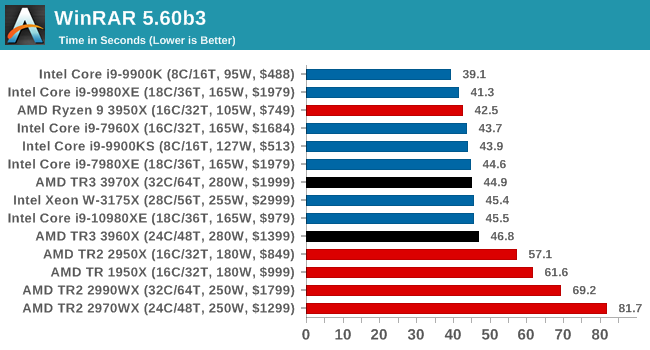
WinRAR is a variably threaded application, and both TR3 processors perform in the same ballpark as anything from Intel. Ideally we should have seen them streak ahead, but we seem to be at a point where CPU frequency or core counts are the limiting factor. At least with Zen 2, there are no issues as there was with Zen 1/Zen+.
AES Encryption: File Security
A number of platforms, particularly mobile devices, are now offering encryption by default with file systems in order to protect the contents. Windows based devices have these options as well, often applied by BitLocker or third-party software. In our AES encryption test, we used the discontinued TrueCrypt for its built-in benchmark, which tests several encryption algorithms directly in memory.
The data we take for this test is the combined AES encrypt/decrypt performance, measured in gigabytes per second. The software does use AES commands for processors that offer hardware selection, however not AVX-512.
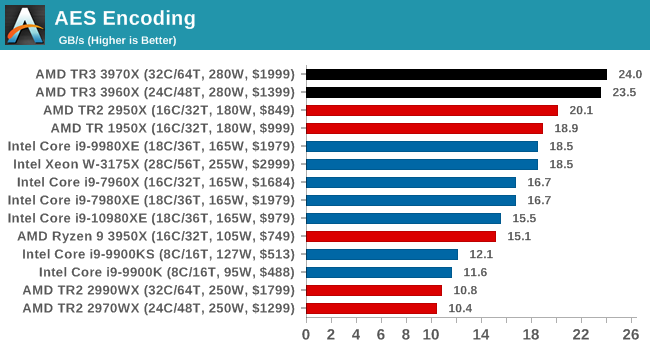










245 Comments
View All Comments
csutcliff - Monday, November 25, 2019 - link
RIP IntelNikosD - Monday, November 25, 2019 - link
It's a bloodpath.Threadrippers destroy even the Xeon W-3175X of 3000$.
Intel is having hard times, no doubt about it.
They look so incompetent nowadays.
melgross - Monday, November 25, 2019 - link
You guys are really funny. Intel had its best year yet, and will have an even better one next year.While you can hope that AMD will take the industry over, it’s never going to happen. We’ve seen that predicted in the past, and it isn’t any truer now.
Xyler94 - Monday, November 25, 2019 - link
The difference though, I don't think Intel can weasel their way through this storm as they did with the Athlon days.They didn't stay in the lead because people didn't want to buy AMD, they stayed because DELL and them were bribbed not to sell AMD, so your average consumer knew nothing about how much better the AMD platforms were.
Intel still holds the performance crown for laptops, which is arguably the bigger segment of the consumer market, but if they don't do something soon, AMD has the performance crown in HEDT and Servers now, both high margin areas, which Intel is super worried about.
Santoval - Monday, November 25, 2019 - link
Next year we will see Comet & Ice Lake based laptops compete with Zen 2 (+ Navi?) based laptops. Zen 2 based laptops will certainly surpass both in CPU performance, so the question is only if they'll be able to surpass the performance of the (Gen11) iGPU of Ice Lake. By that I mean only the parts with the 64 EUs of course, the Gen11 iGPUs with 24 and 48 EUs stand on chance.In any case, it appears that Comet Lake-U/Y will power the largest bulk of Intel's machines, machines with Ice Lake-U/Y will be released in low volume, and Ice Lake-U machines with 64 EU iGPUs will almost certainly be rarer than francium and more expensive than their weight in gold.
Santoval - Monday, November 25, 2019 - link
edit : "stand *no* chance".jabber - Tuesday, November 26, 2019 - link
Guys, some of you may not remember but we've been in this situation before.There was a time that Intel was king and could do no wrong. then about 16 years ago they could not do a thing right and everyone was AMD/SKT939 till the day they died. Ho ho ho!
Then AMD screwed up, Intel got it's act together and AMD was 'so over' etc. etc.
No doubt AMD will screw up again in a couple of years and Intel will get it together again...
Rinse and repeat. Just enjoy the ride.
xrror - Tuesday, November 26, 2019 - link
What really sucked was seeing AMD management at the time just sit there like a sitting duck. People playing with overclocking Pentium M on desktop boards demonstrated nearly a year before Conroe launched that if Intel developed their mobile design into a desktop chip that it would be a monster chip against A64.And Intel did just that.
That said, this time around... Sunny Cove had better start to scale clock wise, else it won't matter that it's 20% faster per clock if it can't actually reach 4Ghz.
It's going to be interesting.
DaBones - Wednesday, November 27, 2019 - link
A quick difference between then and now is that both companies are doing good things. Neither is releasing a dumpster fire of a product, this time around. That's just really cool, and whoever gets shiny, metal hats, I still have some pretty good hardware options!.arcamdomain - Tuesday, December 17, 2019 - link
AMD have never been this ruthless, zen has been a massive turning for all of the market, bringing the prices down and increasing performance from both sides, unfortunately for intel, AMD have the bigger arms in this arms race, TSMC and AMD are already talking about 5nm and 3nm respectively, at which point does this become a ant vs boot scenario.